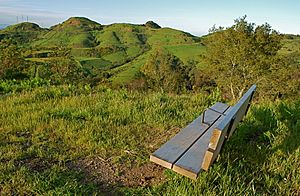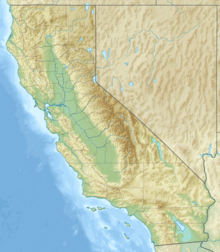Berkeley Hills facts for kids
Quick facts for kids Berkeley Hills |
|
|---|---|
 |
|
| Highest point | |
| Elevation | 581 m (1,906 ft) |
| Geography | |
| Country | United States |
| State | California |
| District | Alameda County |
| Range coordinates | 37°52′58.732″N 122°14′18.886″W / 37.88298111°N 122.23857944°W |
| Topo map | USGS Briones Valley |
The Berkeley Hills are a range of hills in California. They are part of the Pacific Coast Ranges. These hills stand tall on the northeast side of the valley that holds San Francisco Bay. Long ago, they were known as the "Contra Costa Range." This name came from the Spanish words Sierra de la Contra Costa. But after the city of Berkeley and the University of California were built, people started using the name Berkeley Hills.
Contents
Geology: How the Hills Were Formed
The Berkeley Hills are shaped by powerful forces deep within the Earth.
Earthquakes and Faults
Two main faults (cracks in the Earth's crust) define the Berkeley Hills. The large Hayward Fault runs along their western base. A smaller fault, the Wildcat fault, is on their eastern side. These faults are where the Earth's plates meet and move. This movement can cause earthquakes.
Highest Peaks
The highest points in the Berkeley Hills are:
- Grizzly Peak, which is 1,754 feet (535 meters) tall.
- Round Top, which reaches 1,761 feet (537 meters). Round Top is actually an extinct volcano. This means it was once a volcano but is no longer active.
- William Rust Summit, which is 1,004 feet (306 meters) tall.
Vollmer Peak
You might hear about Vollmer Peak, which is 1,905 feet (581 meters) high. Many people think it's part of the Berkeley Hills. However, it's actually on a nearby ridge called San Pablo Ridge. Vollmer Peak is named after August Vollmer. He was the first police chief of Berkeley. Before that, it was called "Bald Peak."
Names for the Hills
People use different names when talking about these hills.
Oakland Hills
Sometimes, you'll hear the term "Oakland Hills." This usually refers to the part of the Berkeley Hills that runs along the east side of Oakland. Technically, "Oakland Hills" isn't an official name on maps. But it's a common way people talk about that area. The Berkeley Hills actually stretch far south into Oakland. They even go past San Leandro Creek to an area called Castro Valley. South of Castro Valley, the hills are often called the San Leandro Hills.
Northern and Eastern Slopes
The name "Berkeley Hills" usually covers the entire ridge up to Wildcat Canyon in Richmond. The eastern slopes of the Berkeley Hills are not in the city of Berkeley. They are located in Contra Costa County.
East Bay Hills
Another common term is East Bay Hills. This name is less clear. It can refer to all the hill ranges east of San Francisco Bay. This includes the Berkeley Hills, the Diablo Range, and all the hills in between.
How the Hills Affect Weather
The Berkeley Hills play a big role in the local weather.
Fog and Warmth
In summer, a cool, moist air layer forms over the ocean. This is called the marine layer. It brings fog and low clouds. This layer is usually less than 2,000 feet deep. The Berkeley Hills are taller than this, so they block the marine layer. This creates a "fog shadow" effect to the east. Areas east of the hills are often warmer and sunnier than areas to the west.
Wind Patterns
The wind that carries the marine layer usually blows from the west. When it hits the Berkeley Hills, it splits. This creates a southerly wind from Berkeley northward. It also causes a northerly wind in the direction of Oakland.
Winter Fog and Rain
In winter, a different kind of fog can form inland. This is called tule fog. It usually stays east of the hills. But sometimes, this inland fog can flow around the hills from the north, through the Carquinez Strait.
The Berkeley Hills also affect rainfall. When wind blows from the southwest during a storm, it hits the hills. The air is forced to rise, which makes it cool down. This cooling causes more moisture to condense, leading to more rain on the western slopes. Areas east of the hills get less rain. Sometimes, very cold storms can even bring wet snow to the peaks.
Fire Danger
In spring and fall, hot, dry, and gusty winds can blow across the hills. These are called Diablo winds. They happen when sinking air from above combines with high pressure inland. These winds create a high fire danger. In the past, these winds have caused major wildfires. Two famous ones are the 1923 Berkeley Fire and the 1991 Oakland firestorm. These fires caused a lot of damage to Berkeley and Oakland.
Images for kids
-
The Berkeley Hills as seen from CA 24 near Orinda.




